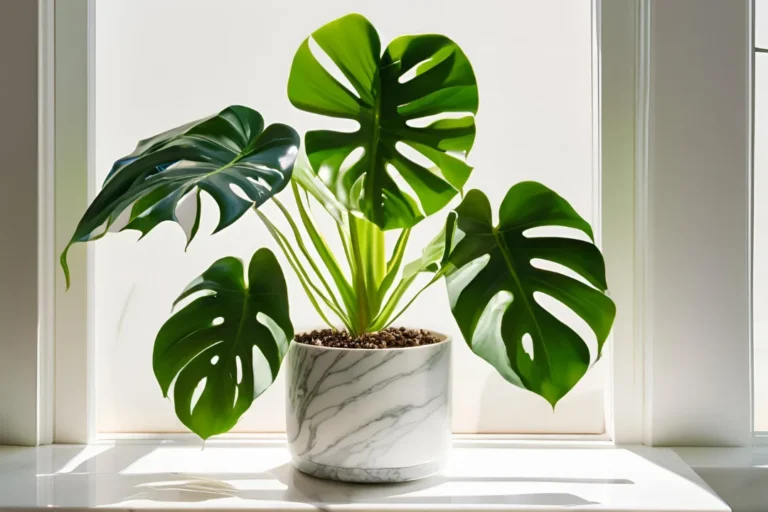If you’ve ever wandered through Pinterest or Instagram looking for houseplant inspiration, you’ve probably come across the iconic Monstera plant. With its dramatic leaves and easygoing vibe, it’s no wonder Monstera plant care has become a hot topic among plant lovers. These tropical beauties are easy to grow, making them perfect for both beginners and seasoned plant enthusiasts.
What Makes Monstera Unique?
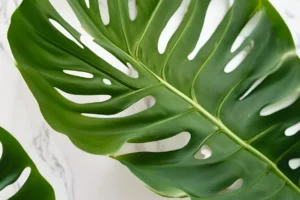
Overview of Monstera Species
Understanding different Monstera species is essential for effective Monstera plant care. Popular varieties like Monstera deliciosa and Monstera adansonii each have their own quirks, but all thrive with proper attention to their watering, light, and humidity needs.
Proper Care for Monstera Plants
Monstera Plant Care Basics: Watering and Soil
When it comes to Monstera plant care, getting the watering routine right is crucial. These plants prefer soil that is moist but not soggy, so allowing the top layer to dry out slightly between waterings is key. Using well-draining soil with peat moss ensures your Monstera’s roots stay healthy.
Sunlight and Placement for Thriving Monstera Plants
Proper placement plays a big role in Monstera plant care. These plants love bright, indirect light. Too much direct sunlight can scorch their beautiful leaves, while too little light might result in leggy growth.
Where Should You Place Your Monstera Plant?
Choosing the right spot is essential for Monstera plant care. A bright, airy corner near a window with filtered sunlight is ideal.
Pest and Disease Prevention for Monstera Plant Health
Keep pests and diseases at bay with these practical Monstera care tips.
The Origins and Natural Habitat of Monstera
Monsteras originate from the lush rainforests of Central and South America. They thrive in humid, shaded environments, climbing trees and reaching for dappled sunlight. Their aerial roots help them cling to trees, making them natural climbers. This adaptability means Monsteras are super forgiving—great news for indoor gardeners who might not have a perfect green thumb yet.
Why Monstera Is a Popular Houseplant
Aesthetic Appeal and Benefits
Monsteras bring a jungle vibe to any space. Their bold, architectural leaves are conversation starters, and they instantly liven up a dull corner. Beyond their looks, Monsteras are known for their air-purifying qualities, helping to reduce pollutants in indoor spaces.
There’s something magical about seeing a Monstera leaf unfurl—it’s like watching a little miracle happen right in your living room. Plus, they’re super photogenic, making them stars in social media snaps.
Common Uses of Monstera in Interior Design
Designers love Monstera plants for their versatility. Whether styled in a minimalist pot or paired with other greenery for a full jungle effect, these plants add depth and personality to any decor. You’ll find Monstera leaves as motifs on wallpapers, fabrics, and even dinnerware, proving their influence goes beyond the plant itself.
Who Should Grow Monstera Plants?
Ideal Conditions for Beginners and Experts
Monsteras are perfect for both plant newbies and seasoned horticulturists. If you’re just starting out, their forgiving nature is a huge plus. They tolerate a bit of neglect, like the occasional missed watering, and bounce back like champs. For plant pros, their size and ability to thrive under the right conditions provide plenty of room for experimentation—hello, propagation projects!
Monsteras enjoy bright, indirect light but can handle low light too. They prefer moist but well-drained soil and don’t require constant fussing. So whether you’re a busy professional or someone who just loves collecting plants, Monstera plants offer something for everyone.
Essential Information About Monstera
Monsteras are more than just pretty plants—they’re fascinating, resilient, and surprisingly easy to care for. Whether you’re looking to grow a lush indoor jungle or just want to keep your Monstera thriving, there’s a lot to know about these tropical beauties. Let’s explore their varieties, care essentials, and ways to tackle common challenges.
Popular Monstera Varieties
Monstera Deliciosa (Swiss Cheese Plant)
Arguably the most iconic of the Monstera species, Monstera deliciosa is the houseplant world’s superstar. Its large, glossy green leaves feature dramatic splits and holes, making it instantly recognizable. This plant can grow massive, with leaves reaching up to three feet wide if given enough space. Native to tropical rainforests, it thrives in bright, indirect light and humid conditions, but don’t worry—it’s pretty forgiving if you don’t live in a rainforest yourself.
Fun fact: The “deliciosa” in its name refers to its fruit, which is edible (though rare in houseplants). The fruit is said to taste like a mix of pineapple and banana!
Monstera Adansonii and Other Types
If Monstera deliciosa is the heavyweight champion, Monstera adansonii is the charming underdog. Often called the “Swiss Cheese Vine,” this variety features smaller, more intricate holes and vines that can trail or climb, making it perfect for hanging baskets or trellises. It’s a bit more delicate than deliciosa, but with proper care, it’s just as rewarding.
Other notable types include Monstera dubia, known for its shingling growth habit, and Monstera obliqua, which is extremely rare and prized for its intricate, lace-like leaves. Each variety brings its own flair, so there’s a Monstera for every style and skill level.
Proper Care for Monstera Plants
Watering and Soil Requirements
When it comes to watering, Monsteras like balance. Overwatering is a common mistake, so it’s essential to let the top inch or two of soil dry out between waterings. Stick your finger in the soil—if it feels dry, it’s time to water. Conversely, soggy soil can lead to root rot, so always use a pot with drainage holes.
Monsteras prefer well-draining soil. A mix of peat moss, perlite, and standard potting soil works wonders. This combination retains enough moisture without becoming waterlogged, mimicking the plant’s natural rainforest floor conditions.
Sunlight Needs and Ideal Placement
Bright, indirect sunlight is a Monstera’s best friend. Place it near an east- or south-facing window for optimal light without the risk of scorching its leaves. If your Monstera starts “reaching” or growing leggy, it’s likely not getting enough light, and a simple repositioning can make all the difference.
Where Do You Put Monstera in Your House?
Monsteras are adaptable, making them ideal for almost any room. You can place them in living rooms, bedrooms, or even bathrooms if there’s enough natural light. Just avoid direct sunlight, which can cause brown, crispy leaf edges. A corner with filtered light or near a sheer-curtained window is perfect.
Fertilizing and Pruning Tips
Monsteras are moderate feeders, so a balanced liquid fertilizer every four to six weeks during the growing season (spring and summer) will keep them thriving. In fall and winter, when growth slows, you can ease up on feeding.
Pruning isn’t just about aesthetics—it’s also about keeping your plant healthy. Snip off any yellowing or damaged leaves and trim back overly long stems to encourage bushier growth. Plus, if you’re into propagation (more on that later!), pruning can give you cuttings to grow new plants.
Addressing Common Concerns
Is Monstera Toxic to Pets?
A key concern for pet owners is whether Monstera plant care is compatible with cats and dogs. Unfortunately, Monsteras are toxic to pets, so keeping them out of reach or choosing alternative pet-friendly plants may be necessary.
Pest Management and Disease Prevention
Even though Monsteras are hardy, pests like spider mites, mealybugs, and scale can occasionally become an issue. Regularly inspecting your plant for signs of pests—such as sticky residue, webbing, or tiny insects—can help you catch problems early. A quick spray with neem oil or a soapy water solution usually does the trick.
For disease prevention, good watering habits are key. Overwatering can lead to fungal infections or root rot, so it’s better to err on the side of underwatering if you’re unsure.
Monsteras are undeniably one of the most captivating houseplants around, but their charm goes beyond appearances. With the right care, they’re a joy to grow and maintain, no matter your level of experience.
How to Propagate Monstera Plants
So, you’ve fallen in love with your Monstera and want to grow more of it? Propagation is where the magic happens. It’s not only rewarding but also a fantastic way to share the Monstera love with friends or add to your own plant collection. Let’s break down the process step by step.
Step-by-Step Propagation Methods
Propagating Through Stem Cuttings
Stem cuttings are the easiest and most common way to propagate a Monstera. Here’s how to do it:
- Choose a Healthy Stem: Look for a stem with at least one node (the little bump where leaves and roots grow). Ideally, it should also have a leaf attached.
- Make a Clean Cut: Using sharp, sterilized scissors or shears, cut the stem just below the node.
- Prepare for Rooting: Remove any lower leaves near the node so they won’t sit in water or soil.
- Decide on Water or Soil: You can root the cutting in water or plant it directly into soil (more on this below).
This method is quick and effective, and seeing those roots develop is so satisfying!
Using Water Versus Soil for Propagation
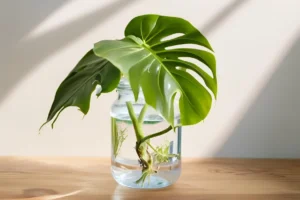
Both water and soil have their pros and cons, so the choice depends on your preference.
- Water Propagation: Place the cutting in a jar of clean, room-temperature water. Ensure the node is submerged, but the leaves stay above water. Change the water every few days to prevent stagnation. Within a few weeks, you’ll see roots forming!
- Soil Propagation: Plant the cutting in moist, well-draining soil. Keep the soil damp but not soggy, and place the pot in a spot with bright, indirect light. This method skips the transplant shock since the roots grow directly in soil.
Tips for Healthy Root Development
For healthy root growth, patience is key. Ensure the cuttings receive plenty of indirect light and maintain consistent moisture levels. In addition, adding a rooting hormone can speed up the process and improve success rates.
Common Challenges in Propagation
Troubleshooting Slow Root Growth
If your cutting isn’t rooting, check its environment. Is it getting enough light? Are you changing the water regularly or keeping the soil evenly moist? Sometimes, temperature plays a role—Monsteras thrive in warm conditions, so make sure the room isn’t too cold.
Avoiding Overwatering During Propagation
While keeping the medium moist is important, overwatering can cause rot, especially in soil propagation. If the cutting appears mushy or the water smells foul, you might need to start over with a new cutting.
Incorporating Monstera Into Your Home
Monstera as a Design Element
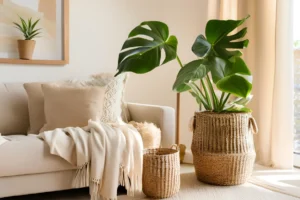
Monstera Plant Care for Indoor Decoration
Learn how Monstera care can enhance your home’s design while keeping your plant thriving.
Decorating with Monstera Plants
Monstera plant care doesn’t just keep your plant healthy—it also enhances your home’s aesthetic. These plants are stunning design elements, and their vibrant green leaves add life to any space.
Monsteras are a dream for home decor enthusiasts. Their large, bold leaves make them a statement piece in any room. Pair a Monstera with a minimalist white pot for a sleek, modern look, or go boho with a woven basket planter. You can even use Monstera leaves in vases for a simple, chic arrangement that lasts weeks.
Matching Monstera with Other Plants
Monsteras pair beautifully with other tropical plants like fiddle-leaf figs, rubber plants, or snake plants. Combining plants of different heights and textures creates a lush, layered effect that feels like an indoor jungle. Pro tip: Add a trailing pothos or ivy for some vertical interest.
Long-Term Care for Mature Plants
As your Monstera grows, it may need extra support. A moss pole or trellis can help it climb, mimicking its natural environment. Regular pruning keeps it manageable and encourages fuller growth. Don’t forget to dust the leaves occasionally—they’ll thank you by looking shinier and absorbing light more effectively.
Final Thoughts on Monstera Care and Enjoyment
Growing and propagating Monsteras isn’t just about creating a thriving plant collection—it’s about connecting with nature and adding a little greenery to your life. Whether you’re a seasoned plant parent or just starting out, Monsteras are a joy to grow. Watching them flourish under your care is a reminder that even small efforts can yield beautiful results.
FAQs About Monstera Plants
How to Propagate Monstera?
Propagating a Monstera is simple and rewarding. The most common method is using stem cuttings. Look for a stem with at least one node, and place it in water or moist soil. In water, change the water every few days to prevent stagnation. If using soil, keep it evenly moist and provide bright, indirect light. Patience is key, as it can take several weeks for roots to develop.
Where Do You Put Monstera in Your House?
Monsteras thrive in bright, indirect light, so placing them near an east- or south-facing window works well. Avoid direct sunlight, which can scorch the leaves, and opt for a spot with consistent warmth and humidity. Bathrooms with good lighting are also a great choice, as the natural humidity mirrors their tropical habitat.
Is Monstera Toxic to Cats?
Yes, Monstera plants are toxic to cats and dogs. The leaves contain calcium oxalate crystals, which can cause mouth irritation, drooling, and vomiting if ingested. To keep pets safe, place the plant out of reach or consider using a pet deterrent spray. If your pet consumes any part of the plant, contact your veterinarian promptly.
How Often Should You Water a Monstera Plant?
Watering frequency depends on the season and environment. Generally, you should water your Monstera when the top inch of soil feels dry. During the growing season (spring and summer), Monsteras may need watering every 7–10 days. In winter, water less frequently as the plant’s growth slows down. Overwatering can cause root rot, so always check the soil first.
Can Monstera Thrive in Low-Light Conditions?
Monsteras can tolerate low-light conditions, but they won’t grow as quickly or develop as many fenestrations. For optimal growth, bright, indirect light is best. If your space is dim, consider supplementing with a grow light to keep your plant happy and healthy.
What Are the Signs of an Unhealthy Monstera?
An unhealthy Monstera may show yellowing leaves, brown edges, or drooping stems. Yellow leaves can indicate overwatering, while brown edges are often a sign of too much direct sunlight or low humidity. Drooping can result from underwatering or poor lighting. Regularly checking your plant’s conditions and adjusting care can help it bounce back.
How Large Can Monstera Plants Grow Indoors?
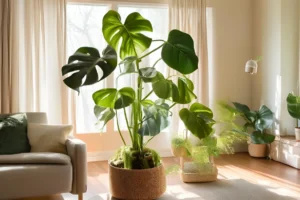
Monsteras can grow impressively large indoors, often reaching heights of 6–10 feet with proper care. Their leaves can grow up to 3 feet wide, creating a stunning focal point in any space. Providing a moss pole or trellis encourages upward growth and keeps the plant manageable as it matures.

